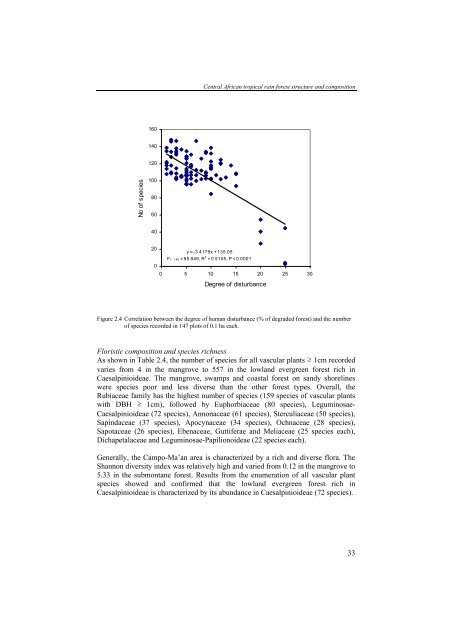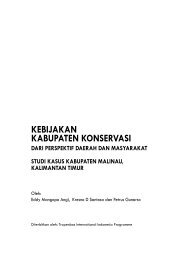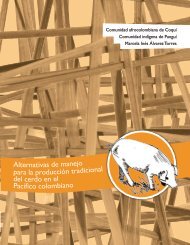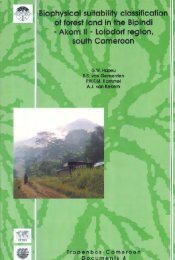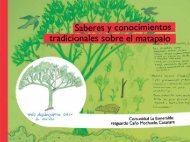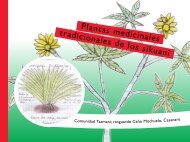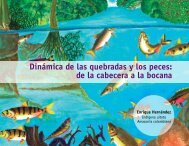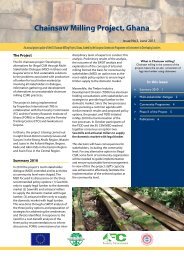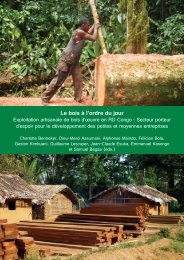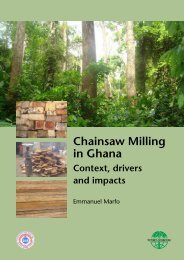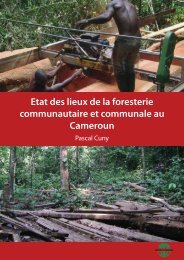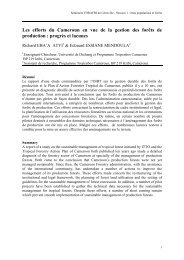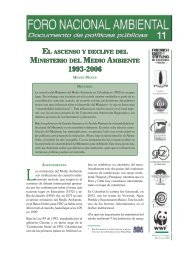Download the publication - Tropenbos International
Download the publication - Tropenbos International
Download the publication - Tropenbos International
Create successful ePaper yourself
Turn your PDF publications into a flip-book with our unique Google optimized e-Paper software.
No of species<br />
160<br />
140<br />
120<br />
100<br />
80<br />
60<br />
40<br />
20<br />
0<br />
Central African tropical rain forest structure and composition<br />
y = -3.4179x + 135.05<br />
F1,145 = 95.946, R 2 = 0.5105, P < 0.0001<br />
0 5 10 15 20 25 30<br />
Degree of disturbance<br />
Figure 2.4 Correlation between <strong>the</strong> degree of human disturbance (% of degraded forest) and <strong>the</strong> number<br />
of species recorded in 147 plots of 0.1 ha each.<br />
Floristic composition and species richness<br />
As shown in Table 2.4, <strong>the</strong> number of species for all vascular plants ≥ 1cm recorded<br />
varies from 4 in <strong>the</strong> mangrove to 557 in <strong>the</strong> lowland evergreen forest rich in<br />
Caesalpinioideae. The mangrove, swamps and coastal forest on sandy shorelines<br />
were species poor and less diverse than <strong>the</strong> o<strong>the</strong>r forest types. Overall, <strong>the</strong><br />
Rubiaceae family has <strong>the</strong> highest number of species (159 species of vascular plants<br />
with DBH ≥ 1cm), followed by Euphorbiaceae (80 species), Leguminosae-<br />
Caesalpinioideae (72 species), Annonaceae (61 species), Sterculiaceae (50 species),<br />
Sapindaceae (37 species), Apocynaceae (34 species), Ochnaceae (28 species),<br />
Sapotaceae (26 species), Ebenaceae, Guttiferae and Meliaceae (25 species each),<br />
Dichapetalaceae and Leguminosae-Papilionoideae (22 species each).<br />
Generally, <strong>the</strong> Campo-Ma’an area is characterized by a rich and diverse flora. The<br />
Shannon diversity index was relatively high and varied from 0.12 in <strong>the</strong> mangrove to<br />
5.33 in <strong>the</strong> submontane forest. Results from <strong>the</strong> enumeration of all vascular plant<br />
species showed and confirmed that <strong>the</strong> lowland evergreen forest rich in<br />
Caesalpinioideae is characterized by its abundance in Caesalpinioideae (72 species).<br />
33


